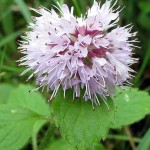Water mint
Home " Bank plants " Water mint
Water thistle. Beautiful flowering marsh plant
Water mint (Mentha Aquatica) is native to large parts of the world. This plant is known for its fresh scent, which is particularly noticeable during warm summer evenings. Water mint is common along banks, but marshy meadows are also a great location for this riparian plant. From June to the end of October, the lilac flowers are a beautiful sight and brighten up the edge of your pond. The plant grows quickly, using offshoots that you can find both above and below ground. The rapid growth ensures that, as with fast-growing oxygen plants, many nutrients are absorbed from the water. Nitrate in particular is favoured by this riparian plant. As a result, watermint competes effectively with algae and is also excellent for use in a helophyte or plant filter.
Want to buy Water mint?
Frequently asked questions
What are the properties of Watermint?
- Latin name: Menyanthes Trifoliata.
- Grows between 15 and 30 cm tall.
- Placement: sun or semi-shade.
- Shallow nutrient-rich water but also in ponds.
- Survives winter due to submerged buds.
- Red pink buds with white flowers.
How do I maintain water mint in the pond?
In addition to the aforementioned beautiful inflorescence and fresh scent, watermint has the property of proliferating. With this proliferation, as described above, many nutrients are (indirectly) absorbed from the water, which is beneficial for the clarity of your pond water. However, chances are that if you let Watermint have its way, the pond bank will quickly become overgrown. A fine-mesh pond basket can save a lot of maintenance, but lifting the basket every now and then and removing the offshoots can greatly facilitate maintenance.
How should I prune water mint?
As described earlier, water mint (Mentha aquatica) can grow and proliferate very quickly. So it helps to prune regularly. Prune in spring and after flowering to encourage growth and maintain the shape of the plant. Cut stems back to just above the ground or to a healthy bud, especially if the plant gets too tall or starts to spread. Also remove dead or damaged leaves regularly to promote healthy growth and prevent the plant from losing too much energy.
Is water mint evergreen?
Water mint is evergreen, it loses its leaves in winter. In autumn, the leaves begin to wilt and die, after which the plant goes into dormancy. Although the above-ground parts die off, the roots and underground stems remain alive, allowing the plant to sprout again in spring.
Is water mint hardy?
Watermint is hardy and can withstand sub-zero temperatures well. Although the above-ground parts die off in winter, the roots and underground shoots survive, so the plant sprouts again in spring. The plant can tolerate even light frosts without sustaining much damage, making it a durable choice for ponds and wet gardens.
What is the planting depth of water mint?
Water mint thrives best in shallow water or moist, boggy soil. Plant the roots at a depth of about 0 to 5 cm under water, or directly in wet soil along the edge of a pond or stream. Make sure the roots make good contact with the mud so that the plant can take root and spread quickly. Deeper water levels can stunt growth, so it is important not to set the plant too deep.
How high can water mint grow?
Water mint can reach a height of 30 to 90 cm, depending on growing conditions. In nutrient-rich, moist soil or shallow water, the plant can grow quite tall, especially during the growing season. The stems are sturdy and can grow upright, often with purplish flowers at the tips that attract insects.
Buy Water Thistle Leaf?

Watermint is for sale through The Pond Master's webshop. Here you can find beautiful bunches of high quality.
